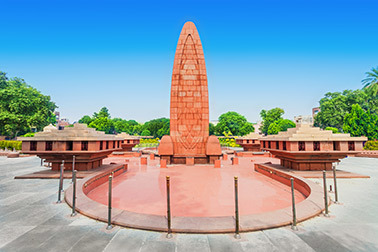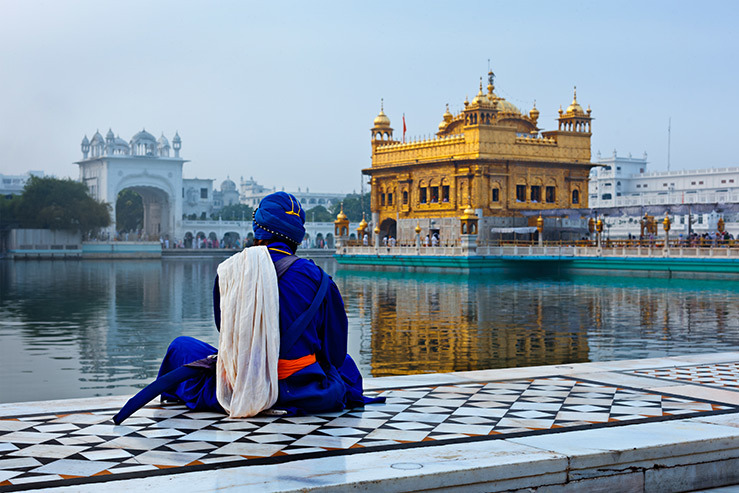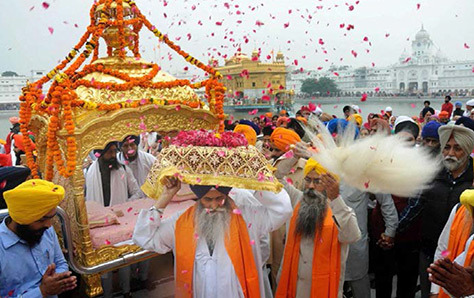A few minutes' walk away is Jallianwala Bagh holding scars of the past. On 13th April 1919, many people from different regions gathered in this historical park to celebrate annual festival of Baisakhi, unaware of the ban imposed by British government for any congregation of more than four people.
As a result, the British army fired on the innocent and unarmed crowd until their ammunition exhausted, leaving hundreds of people dead. The terrified people jumped into the well located inside the park along with their kids to escape the bullets, as the exit of the park was blocked by the British.
 Many of them succumbed to their injuries. A Martyrs memorial has been built around this well, which marks the official figure of 120 bodies recovered from the well. While 1640 round of bullets were fired, 36 bullet marks on the wall have been preserved, recalling the moment when continuous firing was opened without any warning. Within the complex, one can also visit the Martyr's gallery and a museum exhibiting paintings of various leaders, displaying massacre scenes and some newspaper cuttings covering this tragic incident.
Many of them succumbed to their injuries. A Martyrs memorial has been built around this well, which marks the official figure of 120 bodies recovered from the well. While 1640 round of bullets were fired, 36 bullet marks on the wall have been preserved, recalling the moment when continuous firing was opened without any warning. Within the complex, one can also visit the Martyr's gallery and a museum exhibiting paintings of various leaders, displaying massacre scenes and some newspaper cuttings covering this tragic incident.
Little away from the park is Saragarhi Memorial Gurdwara telling the tales of the courage and bravery of Sikh soldiers. Strangely, the Gurudwara was not built by Sikhs but by the British to commemorate 21 Sikh soldiers who fought against the Afghan tribesmen on behalf of the British. Your mind might be questioning what would have made the British to build a memorial Gurudwara. In this battle, 21 Sikh soldiers defended their post from 10000 Afghan tribal invaders until their last breath. Yes, you read it right. It is beyond anyone’s imagination how just 21 soldiers would have resisted 10000 tribesmen for seven long hours. Although they could not survive, they also killed 180 of the tribesmen. Moreover, by engaging the tribesmen for such long hours, the British army at nearby two forts got sufficient time to prepare for the counter attack. Isn't this tale of collective bravery and selfless sacrifice gives you Goosebumps?
INTERESTING FACT: Not only India but Britain too celebrates the Saragarhi Memorial day.
Not very far from here is a
Partition Museum reminding of another horrific past of India's partition in 1947. It had resulted in the largest human migration in the world's history, affecting around 20 million people with an extensive loss of lives and property.

The partition, which divided British India into two independent dominions - India and Pakistan, led to riots that are believed to have killed thousands of people with more than 01 million people becoming refugees. The world's first museum of its kind has been contributed by the partition survivors with the documents, pictures, experiences, and artefacts related to the period before and after the partition.
Interestingly, the streets connecting these monuments to the Golden Temple are dotted with many historical monuments, which make it an interesting walk through them. One can explore Town hall (1866) housing the partition museum, Udasin ashram Akhara Sangalwala (1771), Chitta Akhara (1781), and many more heritage sites in this street. Those who are interested in colonial architecture can visit the DC Office building (1870), General post office building (GPO) (1925), Anglican Church (1859), Victoria Hospital (1900), Catholic Church Ram Bagh etc.

While exploring the history and culture through these lanes, one should not forget to try the
lip-smacking local food. Punjabis (as the locals are called) are big-time foodies and one will find endless food options here to binge upon.
Be it the famous Amritsari Kulcha (stuffed bread), Lassi (butter milk) with a dollop of butter, Amritsari fish tikka, Roasted chicken, Mutton specialities, Jalebies (Sweet Indian funnel cake) or other street food, the options here are endless.
INSIDER TIP: For an ethnic Punjabi lunch, one can choose among the most famous Kesar da Dhaba or Brothers' Dhaba.
For the
shopping spree, one can visit the bustling and vibrant markets of Amritsar and shop their heart out. A one-stop destination for handicrafts, home décor, clothing, carpets, shawls, wooden bangles to fine silver jewellery, the city will delight the shoppers with its markets. One should not forget to buy the traditional Phulkari embroidery dupatta or cloth material, a traditional art form of Punjab, and the charming Punjabi Juttis (shoes). Hall Bazaar, Katra Market, Shastri Market, and Lawrence Road are some of the best places to shop in the city!

While the city is busy with devotees offering prayers at the famed Golden Temple, travellers exploring heritage and shopping sites, and foodies trying various foods, far away from the city,
Wagah Border also attracts many visitors daily.
The attraction here is the
beating the retreat and change of guard ceremony. It is a daily activity that takes place before sunset with a parade by soldiers. The ceremony concludes with the lowering of flag.
Another highlight not too far away from the city is the
‘Craft by Thatheras (metal smiths)’ in Jandiala Guru. The dying art of making copper and brass utensils by the metal smiths here is the first Indian traditional art to be listed under UNESCO's List of the Intangible Cultural Heritage. The metals used copper, brass and certain alloys in making the utensils are believed to be beneficial for health if one drinks or takes a meal out of them.

It is a beautiful traditional skill that includes techniques like using the mud brick kiln, traditional implements, specific type of wood chips, and the specialized process of hammering the metal sheets, a knowledge that is best known only to this community.
Settled in a small town of Jandiala Guru about 10 km from Amristar, Bazar Thatherian (market of the Thatheras) and Gali Kashmirian is the specific settlement where one can find a handful of these metal smiths.
With the sunset, Rehras sahib (evening prayer) in Gurudwara Harmandir Sahib starts and it is followed by
Palki (Palanquin) ceremony. In this ceremony, Guru Granth Sahib (Holy book) is taken back to the dedicated room for night stay, the same way it is brought back in the morning. The colorful and vibrant day of this culturally rich city ends with this ceremony.
The city which wakes up and sleeps spiritually has much more to do and explore throughout the day. Rather than just visiting, one need to absorb its essence, smells and taste that are on offer here. We invite you to come and indulge in the intriguing stories and amazing places to visit when you are here!


 The city wakes up with the sound of chanting and recital of hymns during Palki Ceremony, when Guru Granth Sahib (Holy book of Sikhs), which is the central deity of Golden Temple (Gurudwara Harmandir Sahib), is taken to the main sanctum after a night stay at a dedicated room. As part of daily ritual, Guru Granth Sahib is carried in a Palki (Palanquin) accompanied by devotees singing hymns until they reach the inner sanctum of Gurudwara Harmandir Sahib, which is also called Darbar Sahib by devotees.
The city wakes up with the sound of chanting and recital of hymns during Palki Ceremony, when Guru Granth Sahib (Holy book of Sikhs), which is the central deity of Golden Temple (Gurudwara Harmandir Sahib), is taken to the main sanctum after a night stay at a dedicated room. As part of daily ritual, Guru Granth Sahib is carried in a Palki (Palanquin) accompanied by devotees singing hymns until they reach the inner sanctum of Gurudwara Harmandir Sahib, which is also called Darbar Sahib by devotees.
 After the fourth Sikh guru Ramdas founded the city and created the Sarovar (man-made pool), the fifth Guru Arjan Dev built Sri Harmandir sahib temple, which is the most significant Sikh shrine attracting devotees across the globe.
After the fourth Sikh guru Ramdas founded the city and created the Sarovar (man-made pool), the fifth Guru Arjan Dev built Sri Harmandir sahib temple, which is the most significant Sikh shrine attracting devotees across the globe.
 Many of them succumbed to their injuries. A Martyrs memorial has been built around this well, which marks the official figure of 120 bodies recovered from the well. While 1640 round of bullets were fired, 36 bullet marks on the wall have been preserved, recalling the moment when continuous firing was opened without any warning. Within the complex, one can also visit the Martyr's gallery and a museum exhibiting paintings of various leaders, displaying massacre scenes and some newspaper cuttings covering this tragic incident.
Many of them succumbed to their injuries. A Martyrs memorial has been built around this well, which marks the official figure of 120 bodies recovered from the well. While 1640 round of bullets were fired, 36 bullet marks on the wall have been preserved, recalling the moment when continuous firing was opened without any warning. Within the complex, one can also visit the Martyr's gallery and a museum exhibiting paintings of various leaders, displaying massacre scenes and some newspaper cuttings covering this tragic incident.
 The partition, which divided British India into two independent dominions - India and Pakistan, led to riots that are believed to have killed thousands of people with more than 01 million people becoming refugees. The world's first museum of its kind has been contributed by the partition survivors with the documents, pictures, experiences, and artefacts related to the period before and after the partition.
The partition, which divided British India into two independent dominions - India and Pakistan, led to riots that are believed to have killed thousands of people with more than 01 million people becoming refugees. The world's first museum of its kind has been contributed by the partition survivors with the documents, pictures, experiences, and artefacts related to the period before and after the partition.
 While exploring the history and culture through these lanes, one should not forget to try the lip-smacking local food. Punjabis (as the locals are called) are big-time foodies and one will find endless food options here to binge upon.
While exploring the history and culture through these lanes, one should not forget to try the lip-smacking local food. Punjabis (as the locals are called) are big-time foodies and one will find endless food options here to binge upon.
 While the city is busy with devotees offering prayers at the famed Golden Temple, travellers exploring heritage and shopping sites, and foodies trying various foods, far away from the city, Wagah Border also attracts many visitors daily.
While the city is busy with devotees offering prayers at the famed Golden Temple, travellers exploring heritage and shopping sites, and foodies trying various foods, far away from the city, Wagah Border also attracts many visitors daily.
 It is a beautiful traditional skill that includes techniques like using the mud brick kiln, traditional implements, specific type of wood chips, and the specialized process of hammering the metal sheets, a knowledge that is best known only to this community.
It is a beautiful traditional skill that includes techniques like using the mud brick kiln, traditional implements, specific type of wood chips, and the specialized process of hammering the metal sheets, a knowledge that is best known only to this community.
 We can conduct a virtual destination awareness training program for your team or yourself or a virtual tour for your clients. Let us know the destination of your interest along with your convenient date / time and we will be happy to set up a program for you.
We can conduct a virtual destination awareness training program for your team or yourself or a virtual tour for your clients. Let us know the destination of your interest along with your convenient date / time and we will be happy to set up a program for you.
